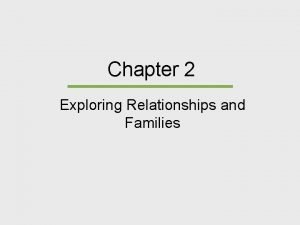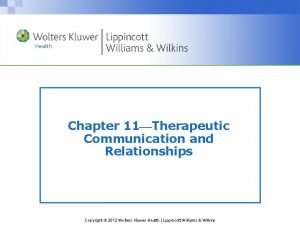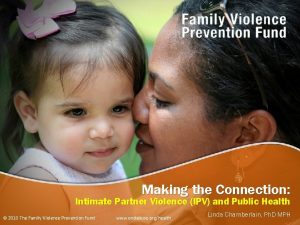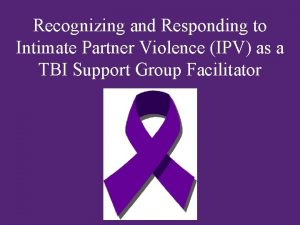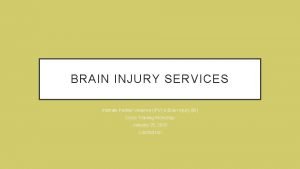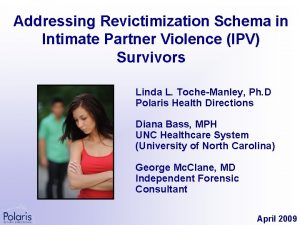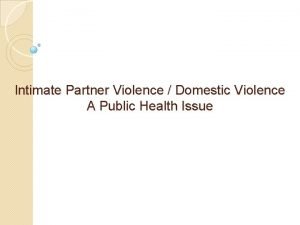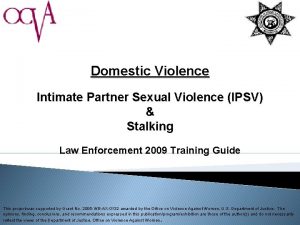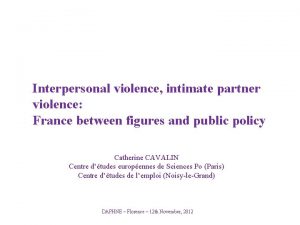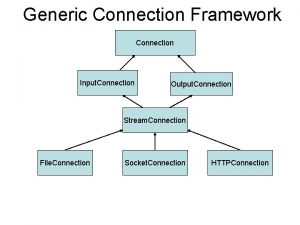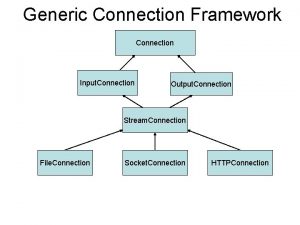Making the Connection Intimate Partner Violence IPV and
















- Slides: 16

Making the Connection: Intimate Partner Violence (IPV) and Public Health © 2010 The Family Violence Prevention Fund www. endabuse. org/health Linda Chamberlain, Ph. D MPH

For more information and program support, contact the National Health Resource Center on Domestic Violence, a project of the Family Violence Prevention Fund: • Monday-Friday (9 -5 PST) • Toll-free (888) Rx-ABUSE (792 -2873) • TTY: (800) 595 -4889 • Online: www. endabuse. org/health In addition, this Power. Point presentation may be downloaded from the Family Violence Prevention Fund's website: www. endabuse. org/health

The National Health Resource Center on Domestic Violence provides specialized materials and tools including: • Consensus Guidelines on Routine Assessment for D. V. • Pediatric Guidelines on Routine Assessment for D. V. • Business Case for Domestic Violence • Multilingual Public Education Materials • Training Videos • Multi-disciplinary policies and procedures • Cultural competency information and materials specific to many communities • Online e-Journal: Family Violence Prevention and Health Practice • Health Cares About Domestic Violence Day (2 nd Wednesday of October annually) Visit www. endabuse. org/health for more information

MENU SELECT FROM THE TOPICS BELOW IPV and Sexually Transmitted Infections/HIV �� Overview IPV and Perinatal Programs Regional and Local Data IPV, Breastfeeding, and Nutritional Supplement Programs Medical Cost Burden and Health Care Utilization for IPV and Child and Adolescent Health The Impact of IPV on Women’s Health ACE Study: Leading Determinants of Health IPV and Behavioral Health IPV and Injury Prevention IPV and Family Planning, Birth Control Sabotage Pregnancy Pressure, and Unintended Pregnancy IPV and Home Visitation Linda Chamberlain, Ph. D MPH

Adverse Childhood Experiences (ACE) Study Leading Determinants of Health

One of the largest investigations ever done to examine the links between adverse childhood experiences and laterlife health • Collaborative between the CDC and Kaiser Permanente • Over 17, 000 study participants • Over 50 scientific publications • www. cdc. gov/nccdphp/ACE 6

Experiences that represent health or social problems of national importance. In this study, adverse childhood experiences included: – Witnessing a mother being battered – Having a parent who has a substance abuse problem, a history of mental illness, or criminal behavior Felitti et al, 1998 7

HOUSEHOLD EXPOSURES Alcohol abuse 23. 5% Mental illness 18. 8% Battered mother 12. 5% Drug abuse 4. 9% Criminal behavior 3. 4% CHILDHOOD ABUSE % Psychological 11. 0% Physical 10. 8% Sexual 22. 0% Felitti et al, 1998 8 %

9 • ACEs are very common and often cluster • ACEs are strong predictors of health behaviors in adolescence and adult life • This combination of findings makes ACEs one of the leading, if not the leading determinant of the health and social wellbeing of our nation

Ischemic heart disease • Cancer • Chronic lung disease • Autoimmune diseases • Anda et al, 2009; Dube et al, 2009; Felitti et al, 1998 10 Skeletal fractures • Liver diseases • Premature death •

Persons with 2 or more ACEs were at for rheumatic diseases Dube et al, 2009 11

• Adults who experienced ACEs had significant and sustained losses in healthrelated quality of life compared to adults without ACEs • These findings should be used in assessing cost-effectiveness of interventions to prevent ACEs Corso et al, 2008 12

• ACEs substantially increase the number of prescriptions and classes of drugs used • The increases in prescription drug use among adults with ACEs are mediated by ACE-related health and social problems Anda et al, 2008 13

Persons with four or more ACEs had: 4 -12 fold increased risk for alcoholism, drug abuse, depression, and suicide attempts 2 -4 fold increased risk for smoking, poor self-rated health, having 50 or more sexual intercourse partners, and sexually transmitted diseases Felitti et al, 1998 14

• There is a persistent grade relationship between ACE scores and initiation of alcohol use by age 14 • ACEs account for a 20% to 70% increased likelihood of alcohol use being initiated during midadolescence (15 -17 years) Dube et al, 2006 15

• The number of ACEs increased dramatically for persons who saw their mothers being battered • As the frequency of witnessing violence increased, there was a positive, graded risk for: – – – Illicit drug use IV drug use Depression Dube et al, 2002 16
 The spyware used in intimate partner violence
The spyware used in intimate partner violence Text to world connection examples
Text to world connection examples Slip critical connection vs bearing connection
Slip critical connection vs bearing connection A325sc bolts
A325sc bolts Slip critical
Slip critical Define the relationship chapter 15
Define the relationship chapter 15 Define the relationship ch 7
Define the relationship ch 7 Friendly relationship chapter 7
Friendly relationship chapter 7 Intimate distance definition
Intimate distance definition Intimate family chapter 6
Intimate family chapter 6 Intimate family chapter 6
Intimate family chapter 6 Meaning of initmacy
Meaning of initmacy Intimate family chapter 2
Intimate family chapter 2 Consultative register
Consultative register Dewgarden foaming intimate wash benefits
Dewgarden foaming intimate wash benefits Intimate zone in communication
Intimate zone in communication Intimate zone in communication
Intimate zone in communication












